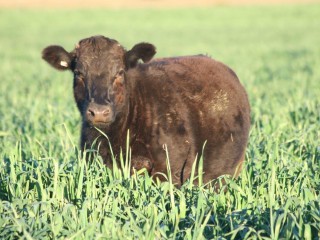 The autumn planting window appears to have delivered a bigger oats crop across eastern Australia this year as producers look to fill looming gaps in paddock feed heading into winter.
The autumn planting window appears to have delivered a bigger oats crop across eastern Australia this year as producers look to fill looming gaps in paddock feed heading into winter.
Pacific Seeds Northern Region Sales Manager Brad Jamieson said sales of oat seed across eastern Australia are running about 10 percent higher than this time last year.
After a dry summer, which had resulted in reduced plantings of forage sorghum and grazing grasses, autumn seed demand for winter forage crops such as oats, grazing wheat and barley and temperate grass species was noticeably higher.
“The impact still probably hasn’t hit us yet because if we had two inches (50mm) in the next week in western Queensland, we would still plant another 5000-10,000ha, of oats, and it would be simple to do if the rain comes at the right time,” Mr Jamieson said.
Queensland Department of Agriculture, Fisheries and Forestry southern regional director Richard Routley agreed that there had been a reasonably large planting of oats in eastern areas of Queensland.
“Because we had that good rain in January and February in eastern parts, there was a reasonable amount of oats planted on that Roma east," Mr Routley said.
“The western side of Roma didn’t get that planting rain and it remains quite dry.”
New South Wales DPI technical specialist, grain services, Peter Matthews, told Beef Central the area planted to forage oats and dual purpose wheat, barley and triticale in the State appeared to be higher this year.
“We have not had a lot of summer or autumn rain, which has meant stock feed is in short supply and growers are looking to get some early feed going into winter to try and carry their stock,” Mr Matthews said.
“The best plantings at the moment would be in the north east quadrant of NSW, where they have had good rain through early summer and early autumn, and the eastern side of the central region is also doing okay, but once you come further south from that it starts to fall away.
“I have just been through central NSW myself and there are a lot of dual purpose crops sown and coming through and they’re looking for moisture and a drink to keep them going.”
At Roma, Landmark’s Rod Turner said a sequence of moderate to small rainfall events in late March/early April, each roughly a week apart, had fuelled planting activity wherever the rain had fallen.
“There was a lot of seed at the office and I don’t think there is a lot left there now,” Mr Turner said.
“Anywhere they have had a bit of rain, the oats is now up about 2-3 inches.”
Mr Turner said he believed the current market was providing some good store buying opportunities for producers fortunate enough to have surplus feed on hand, whether it be grass or planted forage crops.
As drier seasons pushed more cattle towards store sales, at the other end of the market prime cattle were becoming tighter in supply, he said. Of the 2500 cattle yarded at last Thursday's Roma Prime, less than half would have been considered 'proper fat cattle'.
“I don’t think there is any doubt there will be a shortage of finished cattle,” Mr Turner said. “They are probably killing cattle now that they don’t want to kill, where people are selling those 180-200kg dressed weight cattle just to get rid of them off their places.”
He said store cows, currently selling for around 118-120c in Roma, and light steers and heifers were presenting attractive buying options for producers with the feed to carry them through to killable weights in the second half of the year.
Richmond livestock agent Luke Westaway said that there had been a steady flow of buyers coming into the north from central areas of Queensland looking for cow and calf units, currently available for around $500, and steers.
“There are a few traders coming back into the market looking those opportunities, and people looking buy cows and calves to split them and fatten the cow and sell or keep or the weaner as well.”
Tim McHugh, Hogan and McHugh, Townsville, said he had placed cattle for drought-affected local clients on oats as far south as St George and Goondiwindi in recent weeks.
“It wasn’t cheap, but at the end of the day at least the cattle get to a saleable position and we can do something with them,” Mr McHugh said.
“Hopefully somewhere along the line the job will bounce back as supply and demand dictates.
“There is a hell of a premium for EU cattle right now, and I think domestic meatworks cattle are going to be short, they’re a bit concerned for the second half of the year.”



HAVE YOUR SAY